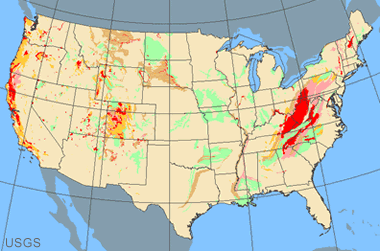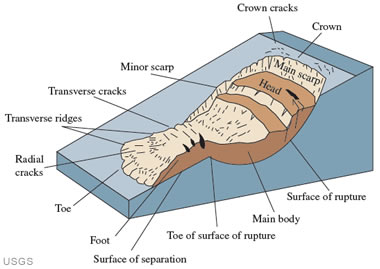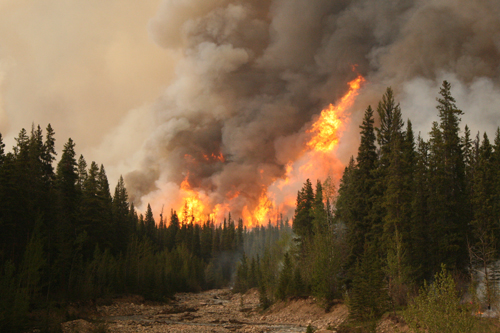Landslide Hazard Information
Landslides cause fatalities and billions of dollars in property damage each year.
Republished from United States Geological Survey Fact Sheet 2004-3072.
| Landslide Incidence and Susceptibility Map |

| USGS map of relative landslide incidence and susceptiblity across the conterminous United States. Red and pink areas have the highest incidence and susceptibility. USGS Map . Enlarge Image |  |
Landslides in the United States cause approximately $3.5 billion (year 2001 dollars) in damage, and kill between 25 and 50 people annually. Casualties in the United States are primarily caused by rockfalls, rock slides, and debris flows. Worldwide, landslides occur and cause thousands of casualties and billions in monetary losses annually.
|
Types of Landslides
The term "landslide" describes a wide variety of processes that result in the downward and outward movement of slope-forming materials including rock, soil, artificial fill, or a combination of these. The materials may move by falling, toppling, sliding, spreading, or flowing. The drawing below is a graphic illustration of a landslide, with the commonly accepted terminology describing its features.
| Anatomy of a Landslide |

| Figure 1. An idealized slump-earth flow showing commonly used nomenclature for labeling the parts of a landslide. Enlarge Image |
Although landslides are primarily associated with mountainous regions, they can also occur in areas of generally low relief. In low-relief areas, landslides occur as cut-andfill failures (roadway and building excavations), river bluff failures, lateral spreading landslides, collapse of mine-waste piles (especially coal), and a wide variety of slope failures associated with quarries and open-pit mines. The most common types of landslides are described and illustrated at right.
SlidesAlthough many types of mass movements are included in the general term "landslide," the more restrictive use of the term refers only to mass movements, where there is a distinct zone of weakness that separates the slide material from more stable underlying material. The two major types of slides are rotational slides and translational slides. Slide types, images and descriptions at right. FlowsThere are five basic categories of flows that differ from one another in fundamental ways. Flow types, images and descriptions at right. Although there are multiple types of causes of landslides, the three that cause most of the damaging landslides around the world are these: Landslides and WaterSlope saturation by water is a primary cause of landslides. This effect can occur in the form of intense rainfall, snowmelt, changes in ground-water levels, and waterlevel changes along coastlines, earth dams, and the banks of lakes, reservoirs, canals, and rivers. Landsliding and flooding are closely allied because both are related to precipitation, runoff, and the saturation of ground by water. In addition, debris flows and mudflows usually occur in small, steep stream channels and often are mistaken for floods; in fact, these two events often occur simultaneously in the same area. Landslides can cause flooding by forming landslide dams that block valleys and stream channels, allowing large amounts of water to back up. This causes backwater flooding and, if the dam fails, subsequent downstream flooding. Also, solid landslide debris can "bulk" or add volume and density to otherwise normal streamflow or cause channel blockages and diversions creating flood conditions or localized erosion. Landslides can also cause overtopping of reservoirs and/or reduced capacity of reservoirs to store water. Landslides and Seismic ActivityLandslides and Volcanic ActivityLandslides due to volcanic activity are some of the most devastating types. Volcanic lava may melt snow at a rapid rate, causing a deluge of rock, soil, ash, and water that accelerates rapidly on the steep slopes of volcanoes, devastating anything in its path. These volcanic debris flows (also known as lahars) reach great distances, once they leave the flanks of the volcano, and can damage structures in flat areas surrounding the volcanoes. The 1980 eruption of Mount St. Helens, in Washington triggered a massive landslide on the north flank of the volcano, the largest landslide in recorded times. Landslide Mitigation - |

